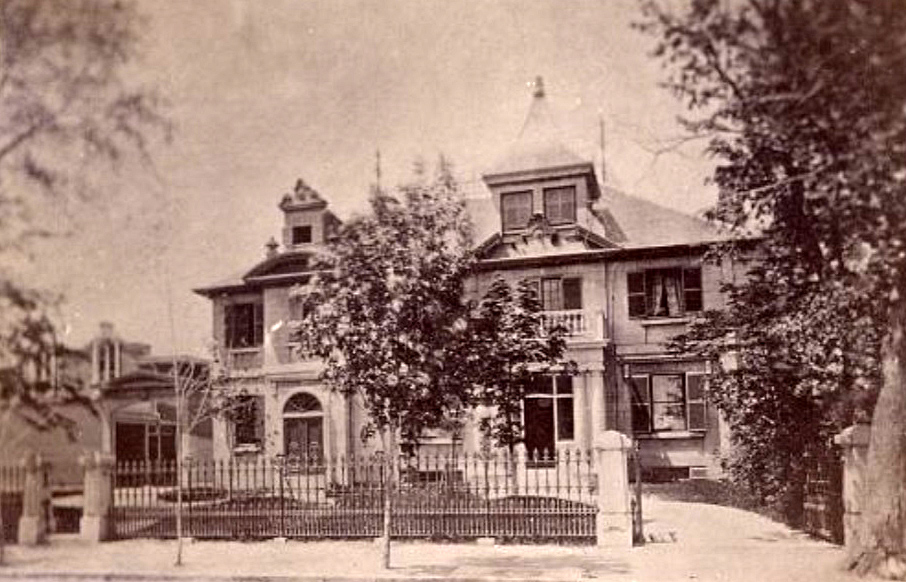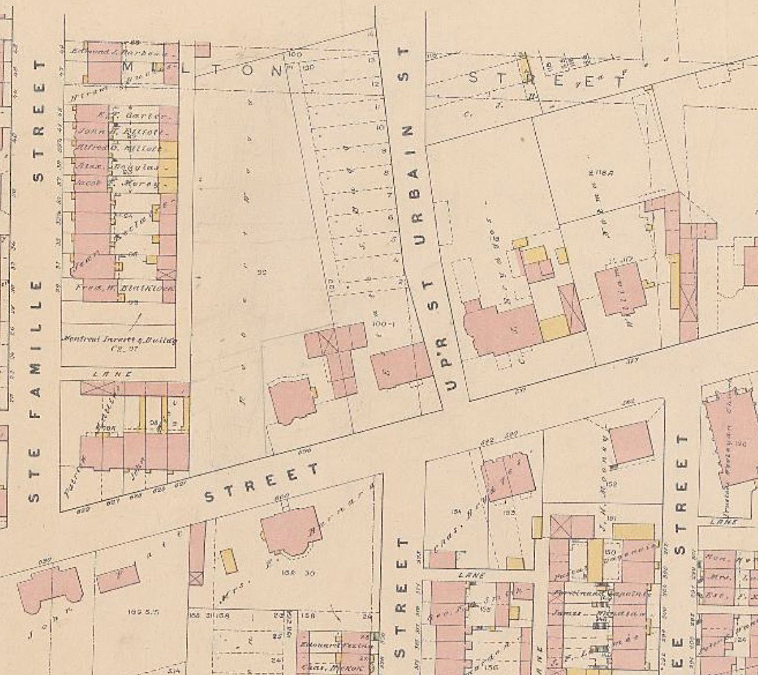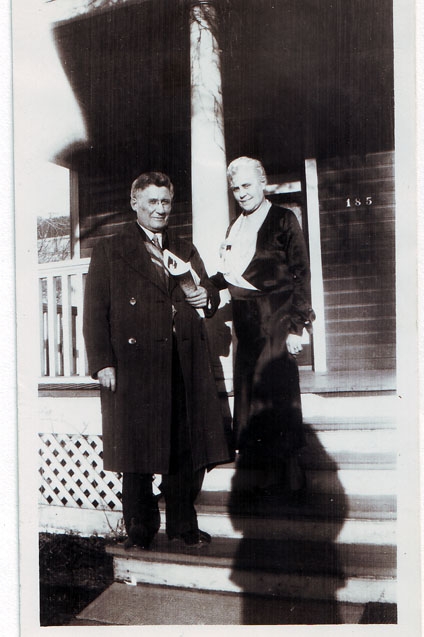
In September 1948, a letter appeared in The Montreal Gazette noting the demolition of Fairmount Villa, a house that had stood on Sherbrooke Street near Saint Urbain for over 100 years.1 Today, that house has been gone for 70 years, but it is still not entirely forgotten: in 1892, Fairmount Avenue, in Montreal’s Mile End neighbourhood, was named to commemorate the house.2
Fairmount Villa was the home of my great-great-grandparents, Montreal notary and landowner Stanley Clark Bagg (1820-1873,) or SCB, and his wife, Catharine Mitcheson Bagg (1822-1914). SCB died of typhoid at age 53, but Catharine continued to live in the house with her son and four daughters until they married, and she remained there until her death at age 92.
After Catharine’s death, the house was sold to the Asch advertising company, which eventually became known as Claude Neon. The City of Montreal expropriated the property in 1948 in order to widen Saint-Urbain Street.
The property records go back 300 years. In 1701, the land on which the house later stood was owned by a religious community known as the Charon Brothers, and the Grey Nuns (Soeurs grises) inherited it in the mid-1700s. Around 1780, the sisters sold three lots at the crest of the hill where Sherbrooke Street was later to become a major artery, and those lots were subdivided and resold several times.3 In 1837, merchant Stanley Bagg purchased lot number 58A at a sheriff’s auction.4 (When a land owner was unable to make his payments, the sheriff seized the property and auctioned it off, often at a bargain price for the new buyer.)

When SCB and Catharine were married in 1844,5 Stanley sold the property to his only son. It was a long, narrow lot at the north-west corner of Sherbrooke Street, running 2½ arpents north along Upper Saint–Urbain Street to the property line of Durham House, where SCB was born and grew up.
The notarial act in which the transfer was recorded described the Fairmount property as having “a two-storey stone house and other buildings thereon erected.”6 The house was probably still under construction in 1844, and SCB and Catharine lived at Durham House with Stanley for a few years. Their first child, who died at age two, was born at Durham House, but the others were all born at Fairmount Villa.
Some years later, an addition was added to the west side of Fairmount Villa. It included SCB’s office and a second front door so that farmers coming to pay the rent they owed to SCB did not have to walk through the house to get to the office.7
In his letter to The Montreal Gazette, SCB and Catharine’s grandson Rev. Sydenham Bagg Lindsay explained that the name Fairmount Villa was reminiscent of Philadelphia. Catharine Mitcheson grew up in a rural area just north of Philadelphia called Spring Garden.8 (It is part of the city today.) Philadelphia’s famous Fairmount Park was located nearby. The naming of Fairmount Villa after a place associated with Catharine’s early life was something of a family tradition: the house in which Catharine grew up was called Menteith House, after Catharine’s mother’s birthplace, Menteith, Perthshire, Scotland.
Sydenham also noted there was a family chapel at Fairmount Villa, called the Oratory of the Holy Cross. “The stained glass window in this chapel depicted Christ as the Savior of the World; it was given in recent years to the Anglican Church at Lake Echo….” 9

Sydenham’s younger brother, Stanley Bagg Lindsay, also recalled visiting Granny Bagg: “We can remember her well sitting at the front drawing room window at Fairmount with her white lace cap on, looking out at the people passing.”10
He continued, “We used to play in Granny’s garden. There were apple trees, especially one which was easy to climb and play house in. There was an iron bench under it, painted blue green…. There was a chestnut tree which we loved, the summer house, the white statutes of Adam and Eve with no arms, … the bleeding hearts, snowballs and lilacs … Nora the housemaid and Jessie the cook, who made good ladies fingers and sponge cakes and who we could always see through large sunken window which gave light to the kitchen.
“There were the stables, the horses, the rockaway and the brougham and Willis the coachman with white mutton chop whiskers whom we liked and who afterwards drove a wagon for Joyce the confectioner. We were very fond of Odell Comtois who did sewing…. She was practically one of the family.
“The garden became very shabby,” he concluded. “It seemed a large garden to us. It went as far as our house which was at the corner of Milton Street. The west side adjoined the Wilson-Smith property. Long before our house was built, a large house called Tara Hall stood just north of Milton Street. Mother [Mary Heloise (Bagg) Lindsay] remembers it burning down one night when she was a child. Where the house used to stand is a street called Tara Hall.”10
Clarifications added Jan. 16, 2020
See also:
Janice Hamilton, “Fanny in Philly” Writing Up the Ancestors, March 29, 2014, https://www.writinguptheancestors.ca/?p=171
Janice Hamilton, “A Home Well Lived In,” Writing Up the Ancestors, Jan. 21, 2014, https://www.writinguptheancestors.ca/?p=181
Photo credits:
Studio of Inglis, “Residence of Stanley Clark Bagg,” 1875, Bibliothèque et Archives nationales du Québec http://numerique.banq.qc.ca/patrimoine/details/52327/1956159 (accessed Dec 6 2019)
Chas. E. Goad, Atlas of the City of Montreal from special survey and official plans, showing all buildings and names of owners, 1881, plate VII; detail of digital image, digital image 10, Bibliothèque et Archives nationales du Québec,http://numerique.banq.qc.ca/patrimoine/details/52327/2246915?docref=MtCYGy_XY512L82RM1ifMA (accessed Dec. 16, 2019)
Photographer unknown. Catharine Mitcheson Bagg in her 90thyear, 1912. Photo glued into the Bagg Family Bible, Bagg Family Fonds, McCord Museum, Montreal.
Sources:
- Sydenham Bagg Lindsay, “Montreal Landmark Destroyed,” Letters From Our Readers, The Montreal Gazette, Sept 1, 1948, p. 6.
- Justin Bur, Yves Desjardins, Jean-Claude Robert, Bernard Vallée et Joshua Wolfe, Dictionnaire Historique du Plateau Mont-Royal, Montréal: Les Éditions Écosociété, 2017, p. 149.
- Justin Bur, email to the author, Dec. 9, 2019.
- J.A. Labadie, Inventory of Stanley Clark Bagg’s Estate, notarial act #16732, 7 June 1875, item no. 236; Bibliothèque et Archives nationales du Québec.
Stanley Bagg only bought about half of lot 58A, but he also purchased two neighbouring lots, greatly expanding the grounds. Later, SCB sold off a part of the property that he didn’t want, creating a long narrow piece of land along Upper Saint Urbain Street that he divided into lots. - The wedding took place on Sept. 9, 1844 at Grace Church, Philadelphia. Historical Society of Pennsylvania; Philadelphia, Pennsylvania; Historic Pennsylvania Church and Town Records; Reel: 1078; database and images; Ancestry.com (www.ancestry.ca, accessed Dec. 16, 2019) entry for Catharine Mitcheson; Citation Year 1844, Pennsylvania and New Jersey, Church and Town Records, 1669-2013, citing Historic Pennsylvania Church and Town Records. Philadelphia, Pennsylvania: Historical Society of Pennsylvania.
- Henry Griffin, notarial act # 20645 (approximate page number;) June 1, 1844; also mentioned as items 235 and 237 in the inventory of SCB’s estate, prepared by J.A. Labadie, notarial act #16732; Bibliothèque et Archives nationales du Québec.
- Stanley Bagg Lindsay, handwritten notes on Stanley Clark Bagg; Lindsay family collection.
- 1840 United States Federal Census, database; Ancestry.com (www.ancestry.ca, accessed Dec. 16, 2019), entry for Robert Mitcheson; Citation Year:1840; Census Place: Spring Garden Ward 1, Philadelphia, Pennsylvania; Roll: 487; Page: 259; Family History Library Film: 0020555; citing Sixth Census of the United States, 1840. (NARA microfilm publication M704, 580 rolls). Records of the Bureau of the Census, Record Group 29. National Archives, Washington, D.C.
- Sydenham Bagg Lindsay, Ibid.
- Stanley Bagg Lindsay, handwritten notes on Catharine Mitcheson; Lindsay family collection.

